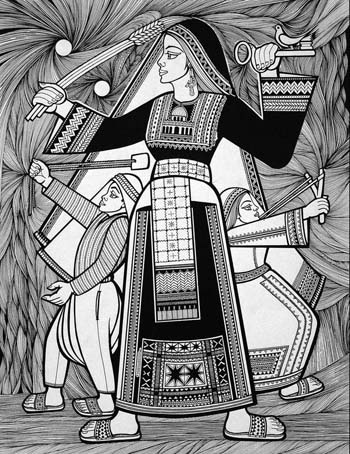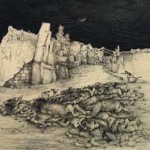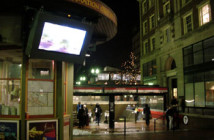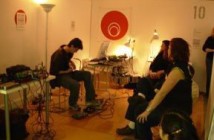For the month of December, the people of the Boston area can go see art by Palestinian artists in person. The Zeitgeist is billing the exhibit, curated by Samia Halaby (a Palestinian artist herself, now based in New York), as a kind of antidote to the runaway merriment of the holiday season, a reminder that different people come from different places and that the same happening will often be pregnant with opposite meanings. For example, the events that occurred in 1948—on land between the Mediterranean and what is now Jordan—were utterly disastrous by just about any reckoning. The UN had partitioned Palestine into two patchwork states, one Jewish and one Arab, and in what seems like a flash, Britain withdrew from the area, Israel declared its independence (which the U.S. promptly recognized), a league of Arab states invaded a well-armed Israel and lost on every front, and, from what I can tell from the news, the Palestinian state seems to have irrevocably dissolved into refugee camps and foxholes. Yet the words used to describe these events are not the same, and cannot match. Israelis call it their War of Independence, Palestinians call this The Catastrophe (al-Nakba), and we call it the Arab-Israeli war. The emotional import of the dates is also exactly opposite: May 14 is celebrated by Israel as the date it declared its independence. Also on May 14, Palestinian people commemorate al-Nakba with a memorial day to remember their collective suffering.
Pieces like Abd al-Naser Amer’s woodcut print Saint (2002) carry this schism: it is a knowing piece, wound really tightly. Saint shows the head and torso of a Semitic man in a stylized, expressionistically carved-out background. The gouges of the carving process make the shadow behind the head into a tightly packed crown of thorns, and a kind of banner across the chest reads, “Wanted for Occupation.” So, it seems that it is Christ who is an unwanted squatter, acting by some mutant combination of religions (well, of powerful governments with the rhetoric of incompatible religions). The occupation statement, rendered with clear deliberateness on the block itself, has however printed up in mirror-reverse. I am tripped up by the backwards inscription—written with the Roman alphabet. I think I get it, but I know that the primary audience is not me, it is either those who can read best right to left, or those in the immediacy of the piece’s origin, or both. I became quite anxious about my calibration in this exhibit—the nuances of the situation as an entity, a set of facts, a mythologized geography, or growing turf all seem out of reach.
The most familiarly styled imagery was in Rania Matar’s documentary photographs of the largely-neglected Palestinian refugee camps in Lebanon. Indeed, the lushly printed photos are even-handedly composed, depicting just enough contextual information to seem like sympathetic record-keeping. In Matar’s statement (she is the only artist who has provided one; she has Boston gallery representation), she writes that she does not intend to carry a political agenda, and that she engages in “humanitarian photographic documentary” practice. Of course, in the context of the exhibit, Matar’s statement is a platitude. And besides, Matar’s statement notes that Lebanon is too scared to acknowledge the continued existence of the camps formally. Lebanon is a country whose own Christian and Islamic populations coexist by such a tenuous truce that it hasn’t taken a census since 1932 for fear of the automatically contentious demographic information it would uncover. It is this fear that denies the Palestinian refugees entry to the societal infrastructure of reliable, paid work or education. When thoughts are turned inwards and banners hidden, partitions harden. These photographs are the verso side to Amer’s woodcut print.
Not every statement in the show is constructed with nested entendres. Across the gallery is the showpiece of the the Art of Palestine exhibit, Abdal Rahman al-Mozayen’s ink drawing, Women and Children of the Intifada (2000). A copy of this beautifully articulated ink drawing is even taped to the gallery window, facing outward to amplify the original inside, just four feet away. It is a large image of a woman and her two children, in defiant, ageless profile against stylized, agricultural thatching. They each wear traditional Palestinian woven dress and are clutching a key and wheat, or slingshots. Each wears a strangely peaceful half-smile; if this were normal art history, I would call it an archaic smile. It is a timeless expression, and a noble image, the kind of liberation art that really does make you feel like standing up straighter.
There is also an important silkscreen from Adnaan Zbeidi, titled “A rose is a rose is a banner.” A poppy looms in the foreground against a simple landscape. The red, green, black and white of the Palestinian flag are prominent. The total is a successful, graphic design. The slogan is written in Arabic, again making it obvious that the text is not pitched to me. All these components, however, are overwritten with history. During the first Intifada, Israel prohibited artists—actually, all Palestinians—from using of the colors of the Palestinian flag at all. Zbeidi spent time in jail for his decision to do so.
How can we resolve all this? Is it possible to acknowledge all histories, as far-fetched as they can seem? For example, it seems like wanton neglect not to write about the actual massacre in the Sabra and Shatila camps: another catastrophe made uncannily universal by a piece in the show, Adnan Yahya’s Sabra & Shatila (from 1983, before the first Intifada). The drawing combines giants with babies and lots of heavy shoes in the foreground that is ever-so-slightly like Philip Guston, but dulls its trauma in its opaque, inky sky, with just a sliver of a crescent moon. In this show, the relationship of the art to its often understated politics can start to seem like that engendered by a clubfoot; in such cases, the beautiful spirit everyone wants to acknowledge must first be separated from the awkward “facts” of the body.
Yet the most striking thing about the show is that nothing in it wants our sympathy. This is not a collection of explicatory art for Westerners. In fact, this is perhaps the only time I have encountered recent images that are essentially Western but which nevertheless do not assume an audience like me. The process by which the work—which spans more than twenty years—was selected, or brought here, is not explained. But, we know that it has arrived here, has been committed to the google-able ether, and now exists in the squishy circuitry of my eyes and brain. These after-experiences remain both foreign and immediate. Obviously, I need to see more Palestinian art.
Links:
Zeitgeist Gallery
"The Art of Palestine" is on view until January 1st at the Zeitgeist Gallery in Inman Square.
All images are courtesy of the artists and the Zeitgeist.







